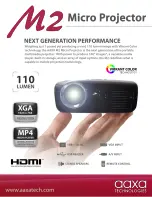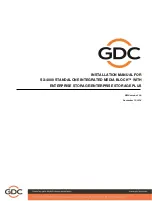
Changing Motor Direction
Two switches control the direction of the two effect motors. Each switch controls one of the motors. The
switches can be adjusted using a small slot-blade screwdriver or probe without opening the unit case. The
switches are accessible between the LED Intensity and Motor Speed controls on the rear panel of the fixture.
The switches are recessed to prevent accidental motor direction changes. Motor direction can be changed by
using a small screwdriver or probe to gently engage the switches, and move the switch toggle or rocker.
Avoid applying excessive force to the switches.
The motion of the projected effect can be significantly altered by changing the direction that the pattern
wheels rotate. Firelight units are shipped with both motors turning the same direction. Due to the
arrangement of the wheels, this produces an effect of overlapping up and down motion, which cancels out to
appear quite neutral with the motors at equal speed. Changing the direction of one motor will alter the
pattern so that all of the effect motion will be upward or downward. If the resulting motion is not in the
desired direction, i.e. up when you want down, then changing the direction of both motors will correct the
pattern motion. To obtain more swirling, or interaction in the effect, one of the motors should be operated at
a slightly faster or slower speed than the other.
Changing Intensity and Color
The fixture electronics have provisions for controlling up to three LED emitters, one each Red, Green, and
Blue, not all of which may be installed.
For each installed emitter, the intensity of the selected color is
adjusted by increasing or decreasing the setting of the matching trimmers. The balance of color between
two or three emitters, and the overall intensity of the fixture may be adjusted to the users requirements by
using these controls as necessary.
Firelight FL-L1 fixtures use a single high power LED emitter, usually white in color, and intensity may be
controlled using the two “Intensity” controls normally assigned to the “Green” and “Blue” emitters. Each of
these two drive channels can operate the LED emitter at half of the maximum current, and both are required
to reach maximum current and intensity. Both of these controls should be adjusted as necessary to obtain
the desired intensity from the effect.
Firelight fixtures may also be equipped with single red or amber LED emitters for single color applications.
The intensity control method for these fixtures will be similar to that for fixtures equipped with white
emitters, but may use only a single drive channel depending upon the maximum current rating of the LED
emitter installed. Contact the manufacturer if you have questions about the intensity control settings for any
fixture configuration.
Dimming
The Firelight FL-L1 fixtures cannot be operated from dimmed AC lighting circuits due to the adaptability of
the “Universal Voltage” power supply provided, which will attempt to compensate for the variable input
voltage. The unit should not be dimmed by attempting to vary the DC power supply voltage either. If
dimming is required in any application, the fixture should be ordered with the DMX control option. This
option will provide full remote control over fixture intensity and effect speed for professional installations.


























